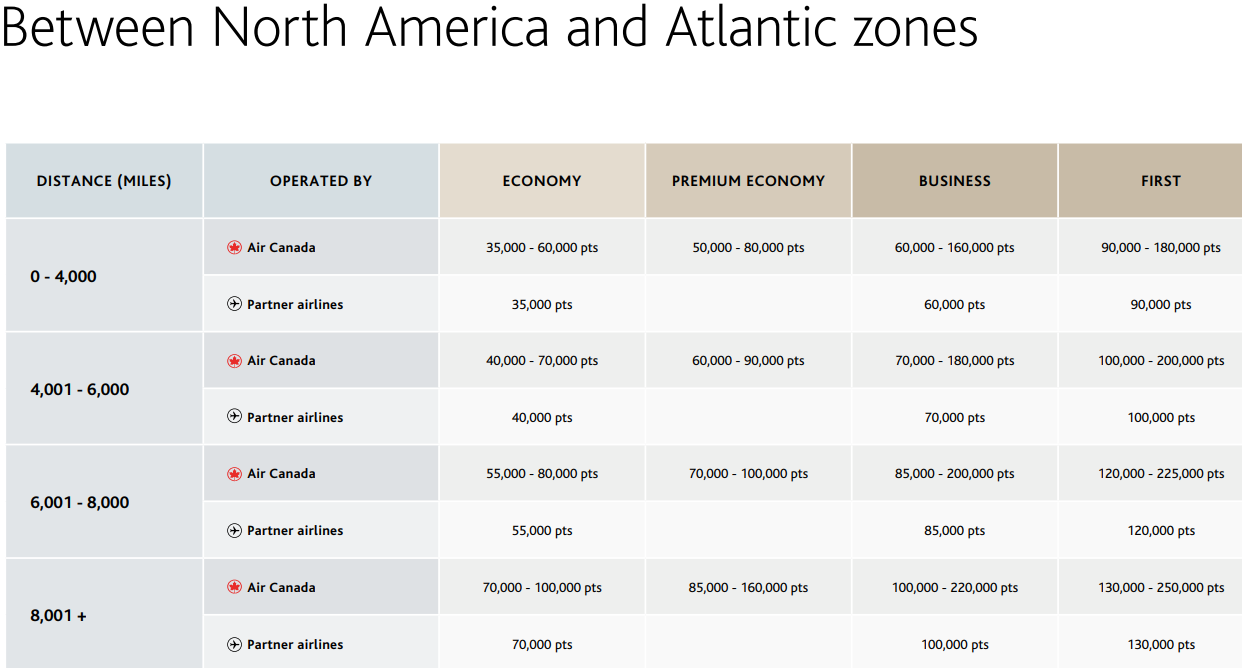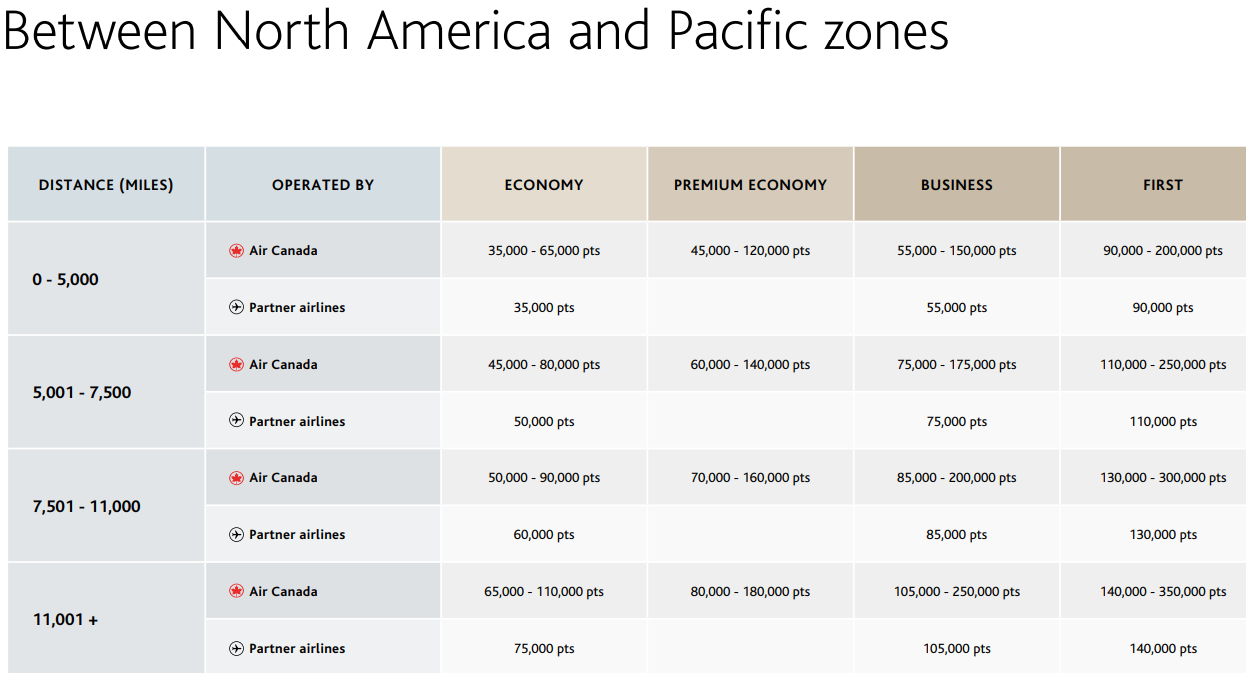Never miss a deal: Follow us on the DansDeals App, WhatsApp, X, Telegram, Instagram, Facebook, SMS, or our Daily Email Digest.
Links may pay us a commission. We appreciate your support! View our advertiser and editorial disclosure here. The content on this page is accurate as of the posting date; however, some of the offers mentioned may have expired.
In 2002 Air Canada decided to spin off its mileage program, Aeroplan, into its own entity.
Air Canada started selling it off in 2005 and completely divested of it by 2008 with Aimia running the Aeroplan program separ`ately from Air Canada.
Experts thought that Air Canada would start a new trend, with airlines realizing big up-front bucks by spinning off their mileage programs.
But the opposite happened. The main value proposition of mileage programs is when they are integrated. That way the airlines can collect the big bucks that banks are shelling out, while offering award tickets that won’t hurt their bottom line. Over time banks have been paying higher and higher fees for miles in order to support their lucrative credit card departments.
Major airlines today lose money on their flying operations, but make money on their mileage operations.
In 2018, Aimia agreed to sell Aeroplan back to Air Canada for $450 million in cash as well as the assumption of $1.9 billion of mileage liabilities. By 2020 Air Canada took over the program and remade it from scratch.
Here are the award charts that the program launched with. The upcoming pricing is in bold below, with some short-haul flights becoming less expensive, while long-haul awards become more expensive.
If you just want to search for the award cost between 2 cities, you can search here.
Air Canada broke the world down into 4 regions, North America, South America, Atlantic, and Pacific:
There are 10 award charts to sift through.
Overly complicated? Definitely.
But it’s a very interesting approach to award chart pricing. It allows Air Canada to accurately price every journey, something that is very difficult for a region based award chart and for a distance based award chart.
In other words using United’s region based award pricing, it can be too expensive to book some awards. Using BA’s distance based award chart it can also be too expensive to book some awards, NYC to Tokyo for 217K miles in business class is ridiculous and adding a connection makes it even more cost prohibitive.
By using a hybrid region and distance based award chart, Air Canada creates valuable award pricing for every route.
Each region has a distance based award chart for travel within that region and to other regions.
While BA’s distanced based award chart dings you for every connection made, Air Canada won’t charge separately for connecting segments. You can create awards with out of the way stopovers, which can be quite lucrative.
Air Canada also doesn’t charge anything for lap children under 2 within the US and Canada. Outside of the US and Canada, an infant ticket can be purchased for just C$25 (currently US$19.47)! This applies to Air Canada and partner airlines flights. That’s a real bargain compared to the 10% of the full fare that US airlines charge, which can make lap children tickets cost prohibitive on a premium cabin award ticket.
Here is the distance chart for flights within North America. Prices listed on all of the award charts chart are one-way, but I’ll compare prices below as round-trip pricing when comparing to the current Air Canada award chart.
Air Canada charges a C$39 booking fee (currently US$30.44) on all partner awards.
None of these awards will be changing:
- A round-trip flight from LaGuardia to Toronto or Montreal on Air Canada starts at 12K miles in coach or 30K miles in business as it’s between 0-500 miles.
- A round-trip flight from Cleveland to Newark on United is 12K miles in coach or 30K miles in business as it’s between 0-500 miles.
- A round-trip flight from Chicago to LaGuardia on United is 20K miles in coach or 40K miles in business as it’s between 501-1,500 miles.
- A round-trip flight from Los Angeles to Newark on United is 25K miles in coach or 50K miles in business as it’s between 1,501-2,750 miles.
- A round-trip flight from Miami to Vancouver on United is 45K miles in coach or 70K miles in business as it’s 2,751+ miles.
- A round-trip flight from Newark to Honolulu on United is 45K miles in coach or 70K miles in business as it’s 2,751+ miles.
- A round-trip flight from Toronto to Honolulu on Air Canada starts at 35K miles in coach or 70K miles in business as it’s 2,751+ miles.
If you’re flying from North America to Europe, Africa, India, or the Middle East, you’ll have to consult this chart:
- A round-trip flight from Newark to London on United is 70K miles in coach or 120K miles in business as it’s between 0-4,000 miles.
- A round-trip flight from Newark to Frankfurt on Lufthansa is 70K miles in coach, 120K miles in business, or 180K miles in first as it’s between 0-4,000 miles.
- A round-trip flight from Newark to Tel Aviv on United is 80K miles in coach or 140K miles in business as it’s between 4,001-6,000 miles.
- A round-trip flight from Newark to Cape Town on United is 110K miles in coach or 170K miles in business as it’s between 6,001-8,000 miles.
- This band will increase from 85K miles in business each way to 90K each way and from 120K miles in first each way to 130K miles in first each way.
- A round-trip flight from Los Angeles to Cape Town on United is 140K miles in coach or 200K miles in business as it’s 8,001+ miles.
- This band will increase from 100K miles in business each way to 110K each way and from 130K miles in first each way to 140K miles in first each way.
If you’re flying from North America to the Far East or Oceania, you’ll have to consult this chart:
- A round-trip flight from Seattle to Tokyo on ANA is 70K miles in coach, 110K miles in business, or 180K miles in first as it’s between 0-5,000 miles.
- A round-trip flight from JFK to Tokyo on ANA is 100K miles in coach, 150K miles in business, or 220K miles in first as it’s between 5,001-7,500 miles.
- A round-trip flight from JFK to Singapore on Singapore is 120K miles in coach, 170K miles in business, or 260K miles as it’s between 7,501-11,000 miles.
- A round-trip flight from Los Angeles to Sydney on United is 120K miles in coach or 170K miles in business as it’s between 7,501-11,000 miles.
- This band will increase from 85K miles in business each way to 87.5K each way.
- A round-trip flight from Newark to Perth on United and Air New Zealand is 150K miles in coach or 210K miles in business as it’s 11,001+ miles.
- This band will increase from 105K miles in business each way to 115K each way and from 140K miles in first each way to 150K miles in first each way.
If you’re flying from North America to South America, you’ll have to consult this chart:
- A round-trip flight from Newark to Bogota on United is currently 50K miles in coach or 75K miles in business. Under the new program it will be 60K miles in coach or 100K miles in business as it’s between 0-4,000 miles.
- A new band will be added for flights between 0-2,500 miles in distance. For Air Canada flights, coach will cost 20K-45K points each way, premium economy will cost 35K-100K points each way, business will cost 40K-150K points each way, and first will cost 60K-175K points each way. For partners, coach will cost 20K points each way, business will cost 40K points each way, and first will cost 60K points each way.
- A round-trip flight from Newark to Lima on United is 60K miles in coach or 100K miles in business as it’s between 2,501-4,000 miles.
- Flights between 2,501-4,000 miles will have the same price as the current 0-4,000 mile band.
- A round-trip flight from Newark to Sao Paulo on United is 80K miles in coach or 120K miles in business as it’s between 4,501+ miles.
Other bands will also see changes,
Between Atlantic and Pacific:
- A new 0-2,500 mile distance band as follows:
- Economy (Air Canada): 25,000-50,000 points
- Premium Economy (Air Canada): 30,000-65,000 points
- Business (Air Canada): 40,000-75,000 points
- First (Air Canada): 50,000-100,000 points
- Economy (Partner): 25,000 points
- Business (Partner): 40,000 points
- First (Partner): 50,000 points
- 2,501-5,000 mile distance band will price as the current 0-5,000 miles
- Premium Economy (Air Canada): 50,000-75,000 points
- 5,001-7,000 mile distance band
- Premium Economy (Air Canada): 65,000-80,000 points
- 7,001+ mile distance band
- Premium Economy (Air Canada): 80,000-110,000 points
- Economy (Partner): Increases from 60,000 to 65,000 points
- Business (Partner): Increases from 100,000 to 110,000 points
- First (Partner): Increases from 130,000 to 140,000 points
Within South America:
- A new 0-1,600 mile distance band as follows:
- Economy (Partner): 10,000 points
- Business (Partner): 20,000 points
- First (Partner): 30,000 points
- 1,601+ mile distance band
- Economy (Partner): Increases from 15,000 to 20,000 points
- Business (Partner): Increases from 30,000 to 35,000 points
Overall these are incremental changes and not an awful devaluation. And it’s great that Air Canada still has award charts!
What do you think of these changes and the Air Canada program?


![[Cancellation Updates, Arkia Adds Athens Connection] Here Are The Current And Next Available Flights To Israel On More Than 40 Airlines!](https://i.dansdeals.com/wp-content/uploads/2020/08/16160333/dansdeals-glitch-fare-1024x538-1-286x150.jpg)






![[Less Than 1 Hour Left!] After Major United Card Shakeup, Which Card Should You Have?](https://i.dansdeals.com/wp-content/uploads/2019/02/24173754/12696032183_0d9622ae98_z-267x150.jpg)













![[AMEX Explains Upcoming Points Transfer Pause To Emirates] Ultimate Guide To Bank Points Transfers; Including All Current Bonuses And Transfer Times!](https://i.dansdeals.com/wp-content/uploads/2020/08/16160333/dansdeals-glitch-fare-1024x538-1-133x70.jpg)




Leave a Reply
13 Comments On "Less Than 2 Years After Launch, Air Canada Will Make Changes To Award Charts"
All opinions expressed below are user generated and the opinions aren’t provided, reviewed or endorsed by any advertiser or DansDeals.
air canada never has any directa
It’s interesting that a flight from LGA-Toronto is not lowered to be in sync with the award chart.
Though a great write up. Very clear and easy to use.
I guess they learned from united how to make things more complicated.
When all the airline award programs keep on devaluing how are they making money of them?
Assuming people are using their point system a lot less.
Are there better miles deals between NYC – TLV than this?
Yes
If there’s award availability the. Avianca should be you choice.
No ?
Dan should update The Ultimate Israel Mileage Award Chart that he did way back in 2015.
For United flights, ANA is 65K round trip.
I was planning on booking a trip on EVA using ANA miles. But called EVA and lap infant $1300. Are you saying if I book it using aeroplan I can pay C$25?
Correct.
Amazing! Now the trick will be convincing ANA to let me book only my 3 year old as the adults will be booked using Aeroplan and EVA.
I flew elal business using Qantas points and lap child was $22
hey dan is the best way to book united tickets with aeroplan?